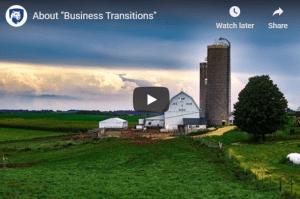I have been learning a lot about the different aspects involved in succession planning this summer while looking into farmers’ needs surrounding this topic. One of the big things I have discovered is that succession planning involves gathering and organizing a lot of information about your farm business, and with that comes a lot of time: time to gather farm documents and records, time to have important conversations with family and non-family, and time to draft and finalize the transfer documents. Frankly, just thinking about all of this can be overwhelming and leave you wondering where to start.
Fortunately, many state extension programs have resources to help you start to learn about and navigate the process of planning for farm succession. I recently completed an online course through Penn State Extension called Business Transitions: Family Farm and Business Succession Planning and would like to share my thoughts not only as a student but also as the junior generation on my family’s 50-cow dairy farm.
It can be difficult to initiate a discussion on succession planning with the partners and potential future partners of a business. I would recommend this online course as a great starting point for farm families who are thinking about beginning a transition plan or have recently started one. The course is taught by John Berry, a Penn State Extension educator and former dairy farmer, and Matt Kaplan, a professor of Agriculture and Extension at Penn State with a focus on family communication strategies.
The instructors break the course down into eight sections that provide a basic understanding of components and considerations that should go into forming a plan, such as:
- Determining family and business goals
- Creating an accurate record of farm assets
- Understanding different strategies and options
- Considering the people (professionals and family) that should be involved
This course is not a substitute for legal advice and professional council, but is does provide an understanding of the transition process and steps to consider before involving a professional to get the most for your money.

What I Liked
The introduction clearly laid out how to navigate the course. It showed you where everything was on the course page and how to find the course outline, which was broken down into clearly labeled sections and sub sections for easy navigation.
The order of each section. Overall, the layout of each section followed a logical order that started with developing an understanding of the different types of planning (business, retirement, estate, and succession) before considering communication and goal setting strategies and ending with the components of a succession plan.
The course combined both videos and reading into short, easy to follow sections that built on your understanding. Each sub-section could generally be completed in around 10 minutes and typically contained a few paragraphs of reading and a video that ranged from 3 to 5 minutes in length. I enjoyed this because it provided convenient places to stop and think about what I had just learned. This structure makes it easy for farmers to work through the material as they have time.
There were no deadlines. Once you register for the course, you have access to all the materials for 60 days, so you are free to work through the course when you want and at your own pace, an aspect helpful for busy farmers and families.
It followed the journey of a farm family as they worked through each section of the process. I found this helpful because it portrayed an application of the topic discussed in each section as well as revealed the thoughts of the family members involved as they moved through the process.
Activities and handouts were available to stimulate discussion among the family. Many of these are available to download so they can be used after the course ends to continue working through the process as you make time.
Each section ended with review questions to see what you learned. This was helpful for understanding the different terms and concepts discussed within each section.
What I Would Improve
Having an option to interact with the instructors. All of the videos that were a part of the course were pre-recorded so there was no way to ask questions if you wanted. I think incorporating a way to submit questions would have been helpful and enhanced the course, making it more interactive.
Moving Section 5: Establishing Goals. While the majority of the course is laid out quite well, the section on establishing goals would have fit better after the discussion on family dynamics and communication, since goal writing ties closely with communicating across the family.
Making sure all the links in the resource page are up to date. While this does not take away from the value of the course, I did notice a couple links that did not work like they should, so updating them would be helpful in case anyone wants to look deeper into information on certain topics.
Final Thoughts
Overall, this course provides a balanced set of information and strategies to consider that can help frame how you approach and think about moving forward with the succession planning process. These considerations breakdown the process into steps you can start working on with your family now and provide basic tools to organize decisions that are made after talking with family members and other business partners.
This course would be a great tool for engaging the entire family and all business partners in conversations that are important to have before making a plan for the future. It also provides a strong foundation to begin conversations with a local extension agent who may be able to provide additional resources and support. I would highly encourage any family farm or business thinking about planning for the future to explore online course options like this because starting to plan now can prevent a lot of headaches in the future.
Resources
Business Transitions: Family Farm and Business Succession Planning

